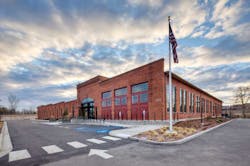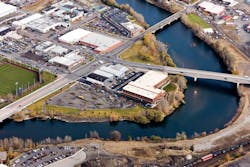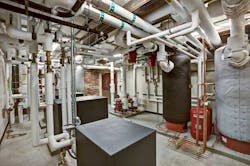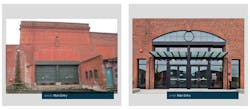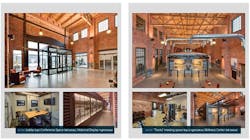McKinstry combines LEED Gold, historic preservation at its new SIERR Building HQ
SPOKANE, WASH. — Trade is what made Spokane a settlement, but it was the railroad that made it a city. First came the Northern Pacific in 1881, soon followed by the Union Pacific, the Great Northern, and then the Chicago, Milwaukee, St. Paul and Pacific Railroads.
By 1907 it was the first electrified city in Washington State with an electric streetcar system called the Spokane & Inland Empire Railroad (SIERR). The main SIERR Building was a 68,000-sq.ft. space to store and maintain streetcars. Later, the Great Northern Railroad began using the building as a station to work on its engines while the streetcars were out.
But by the 1940s buses were a more economical, flexible way to ferry people around. By the 1950s the SIERR Building was converted to warehousing and the windows were blocked off with concrete masonry units.
As the decades wore on the roof deteriorated, and the trestles were in such bad shape that stacks of pallets were being used as temporary support.
That was the sorry state of the building when McKinstry, a full-service design-build contracting firm, came scouting locations for their new Inland Northwest Headquarters.
“Everything had been torn apart on the inside,” says Kim Pearman-Gillman, McKinstry’s director of strategic market development, “but it had this amazing, beautiful ‘bone structure’ to it. Our architects and our owner could see a vision of what it could become.”
McKinstry Station
That vision was of a spacious, comfortable, state-of-the art green office space, both for McKinstry and its tenants: McKinstry Station. Standing in the way of that vision was decades of neglect, a building envelope that had never been designed for heating and cooling, and a spot on the list of the National Register of Historic places that meant that no changes could be made affecting the essential historic character of the building.
Clearly, McKinstry felt it was a company equal to the challenge. Founded in 1960, the company has been in the Spokane region the past 12 years. Their clients include school districts, data centers, even major search engine companies. It is currently privately owned and employs about 1,800 workers.
“McKinstry has been practicing design-build since 1965” says John Lang, director of design services for McKinstry. “The company has always prided itself on anticipating what the next move needs to be, on where the industry needs to be, and to be leaders in that effort.”
That spirit of innovation comes from the very top. According to Jared Haight, the lead mechanical engineer on the project, “Dean Allen, the leader of our company, the CEO, has always driven home the engineering core competency, and with that the innovation that goes along with critical thinking, specifically focused on energy efficiency.”
First steps
Work began with a demolition phase in August of 2010. 95% of demo material ended up being recycled. McKinstry coordinated closely with local recycling centers. Material reuse opportunities were identified, not just for use on the project, but to donate to the local chapter of Habitat for Humanity. Hazardous materials were removed and remediated with the help of an environmental consultant.
While the permitting process went smoothly at the local and state level, at the federal level the National Park Service created some very high hurdles for McKinstry to overcome. For one example, 12 different methods for cleaning brick were put forward, each one keeping in mind the short- and long-term effects on the brick and mortar.
For another, the insulation, a key component of any green building, had to be removable. “Whatever you do to the building, whatever improvements for its new use, it has to be able to be removed without damaging the original building,” says John Lang. Eventually McKinstry decided on a sprayed-on urethane foam. Only when they demonstrated it could be easily scraped off without damaging the underlying brick did it become acceptable to the Park Service.
The nuts and bolts
When it came to the building’s mechanical systems, energy efficiency was at odds with preservation, so it was up to innovation to bridge the gap.
“We ended up using ground-source heat pumps,” says Haight. “The horsepower behind the building is a closed-loop, ground-water heat pump system. We have 25, 185-ft. deep bore holes in a bore field underneath the parking lot … the system was optimized such that the bore field along with the heat pumps will generate the entire building’s cooling capacity and 60% of its heating capacity.”
The water-to-water heat pumps are Carrier, Model 50PSWs; the water-to-air heat pumps were also from Carrier, Model 50PCH, with additional heating delivered by Knight XL condensing boilers from Lochinvar, Model KBN. All the hydronic pumps were from Armstrong.
The building’s location by a bend in the Spokane River is ideally suited to a ground-water based system. The water is actually flowing away from the river through the gravelly soil, leading to greater efficiency.
“I’m going from memory,” says Lang, “but I think our original bores were going to be 250- to 300-ft. deep. When we did our first test well, the flow was so good we were able to reduce it to 185-ft. When you’re drilling 25 wells that’s a huge savings.”
On the distribution side, the ground-source heat pump is coupled to a condenser water loop. The loop serves any heat pumps in the building. Main areas are heated and cooled through radiant in-slab piping with individual zones in the concrete slab.
“Couple that with the condenser water system and a series of three-way valves that engages either the heating water loop or the chilled water loop, so that condenser water system has two independent heating and cooling loops run through the heat pump,” says Haight.
If a particular zone calls for cooling, chilled water is cycled through the loop. A secondary two-way valve is either flow/no flow, so the temperature of the slab falls until it reaches the desired temperature. The reverse happens during heating. Any location within the building that had in-slab heating/cooling also had a dedicated outside air unit — an Aaon Model RN — with heat recovery to squeeze every last Btu out of the system while ensuring fresh outside air.
Fine touches
The use of radiant heating and cooling was key. For one thing, with the high ceilings in the SIERR Building, it would be inefficient to try to heat and cool so much empty space. Now the heating and cooling power is down by the occupants, right where it needs to be. For another, a radiant cooling system eliminated the need for a cooling tower, helping preserve the building’s original exterior.
“One of the big things historic preservationists don’t want you to mess up is the façade,” says Pearman-Gillman.
Keep in mind, this was 2010-2011, and large-scale use of radiant cooling was far from common. But because McKinstry saw the potential of the technology they decided to make their own headquarters a test-case. It was a point of pride for Haight.
“I love the leadership that said, ‘You know, we’re going to do it on our building. If we can’t do it on our own building and make it work, we’re not going to do it on anybody else’s.’”
Another innovative approach was taken to the building’s server room. “The unit serving that equipment is evaporative cooling,” Haight says. “If there’s waste heat from that space and the general space is in a heating mode, rather than dump that waste heat outside there’s a series of dampers that would instead dump the heat into occupied space.”
Water efficiency was also high on McKinstry’s list of priorities. The building has its own rainwater harvesting system, and uses low-flow faucets, fixtures, urinals and toilets from Toto. The toilets and urinals feature self-generating flush valves that use the flow of water to create all the electrical power their actuators require.
As with any high efficiency system, optimizing system controls was vital. Because of slow recovery times in the radiant slab, constantly trying to heat then cool then heat the same space would be an enormous waste of energy.
The building automation system uses feedback from space temperatures, slab temperatures and space dew points. “It has an active learning loop,” says Haight. “It can tell how long it took yesterday to get up to temperature based on that day’s outside air. Then it will look at the outside temperature today and calculate what time it needs to start to get to where it needs to be by occupied hours.”
Moving day
The $20 million project was completed by October of 2011, with occupants moving in by November. “It’s incredibly comfortable,” says Haight, who works in the building. “We’ve had a few issues with the heat pumps, but nothing out of the ordinary.”
By the time the commissioning process was finished, the SIERR Building at McKinstry Station was certified LEED Gold, making it one of the few high-performing historical buildings in the United States.
McKinstry only takes up about 30,000-sq.ft. of the space. The rest is given over to common areas — some of which are reminiscent of train or trolley cars in shape — and to tenants, most of them start-up companies that embody the innovative spirit McKinstry has at the heart of its own company culture. “It’s really what I consider a pay-it-forward strategy that McKinstry is very much into,” says Pearman-Gillman.
Having tenants has meant sometimes customizing mechanical systems to suit a certain business. For example, one tenant, Paw Print Genetics, has a wet lab on the premises, with its own stringent water, power and ventilation requirements.
Reflecting on the entire process, John Lang has nothing but gratitude towards the City of Spokane, and admiration for his team members, which include not just his fellow workers at McKinstry, but also the project’s GC, Spokane-based Lydig Construction.
“They did a fantastic job,” Lang says. “The superintendant they had was absolutely outstanding. He could foresee many problems before they arose and was very collaborative in the solutions that you see in the finished building.”
About the Author
Steve Spaulding
Editor-in-Chief - CONTRACTOR
Steve Spaulding is Editor-in-Chief for CONTRACTOR Magazine. He has been with the magazine since 1996, and has contributed to Radiant Living, NATE Magazine, and other Endeavor Media properties.
